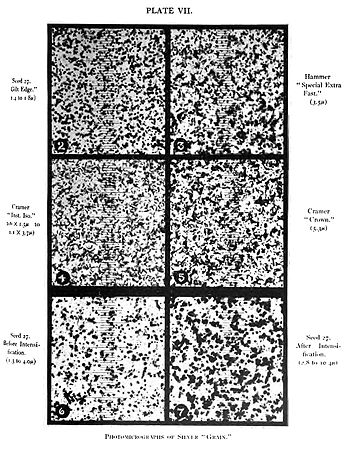
Film grain
Encyclopedia

Photographic film
Photographic film is a sheet of plastic coated with an emulsion containing light-sensitive silver halide salts with variable crystal sizes that determine the sensitivity, contrast and resolution of the film...
due to the presence of small particles of a metallic silver, or dye clouds, developed from silver halide
Silver halide
A silver halide is one of the compounds formed between silver and one of the halogens — silver bromide , chloride , iodide , and three forms of silver fluorides. As a group, they are often referred to as the silver halides, and are often given the pseudo-chemical notation AgX...
that have received enough photons. While film grain is a function of such particles (or dye clouds) it is not the same thing as such. It is an optical effect, the magnitude of which (amount of grain) depends on both the film stock and the definition at which it is observed. It can be objectionably noticeable in an over-enlarged photographic film photograph.
RMS granularity
Granularity, or RMS granularity, is a numerical quantification of film-grain noise, equal to the root-mean-square (rms) fluctuations in optical density, measured with a microdensitometerDensitometer
A densitometer is a device that measures the degree of darkness of a photographic or semitransparent material or of a reflecting surface. The densitometer is basically a light source aimed at a photoelectric cell. It determines the density of a sample placed between the light source and the...
with a 0.048 mm (48-micrometre) diameter circular aperture, on a film area that has been exposed and normally developed to a mean density of 1.0 D (that is, it transmits 10% of light incident on it).
Granularity is sometimes quoted as "diffuse RMS granularity times 1000", so that a film with granularity 10 means an rms density fluctuation of 0.010 in the standard aperture area.
When the particles of silver are small, the standard aperture area measures an average of many particles, so the granularity is small. When the particles are large, fewer are averaged in the standard area, so there is a larger random fluctuation, and a higher granularity number.
The standard 0.048 mm aperture size derives from a drill bit used by an employee of Kodak.
Selwyn granularity
Film grain is also sometimes quantified in a way that is relative independent of size of the aperture through which the microdensitometer measures it, using R. Selwyn's observation (known as Selwyn's law) that, for a not too small aperture, the product of RMS granularity and the square root of aperture area tends be independent of the aperture size. The Selwyn granularity is defined as:
where σ is the RMS granularity and a is the aperture area.
Grain effect with film and digital
The images below show an example of extreme film grain:Digital photography does not exhibit film grain, since there is no film for any grain to exist within. The effect of film grain can be simulated in some digital photo manipulation programs, such as Photoshop, adding grain to a digital image after it is taken.
In digital photography, image noise
Image noise
Image noise is random variation of brightness or color information in images, and is usually an aspect of electronic noise. It can be produced by the sensor and circuitry of a scanner or digital camera...
sometimes appears as a "grain-like" effect.
Film grain overlay
Film grain overlay, sometimes referred to as "FGO," is a process in which film emulsion characteristics are overlaid using different levels of opacity onto a digital file. This process adds film noise characteristics, and in instances with moving images, subtle flicker to the more sterile looking digital medium.As opposed to computer plug-ins, FGO is typically derived from actual film grain samples taken from film, shot against a gray card.

